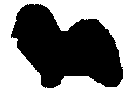
COLOUR GENETICS - E locus
The E gene locus holds the EXTENSION gene. This is the gene that controls production of dark pigment, and determines whether or not to make it as well as the extent to which it will be made. It can only deposit the colour it makes according to the directions of A and K. The order of dominance is [ Em ], [ E ] and then [ e ]. It is important to note that[ Em ] is dominant to [ E ] but that "m" only affects a small area on the dog, and E expresses itself on the rest of the dog (according to A and K) which is why you get masked sables, masked brindles etc. Mask expression can range from covering the entire head to just raccoon eyes or a dark muzzle. A face mask in some cases comes in combination with dark dorsal stripe and occasionally darker paws and tail tip(this perhaps an interplay with other genes or modifiers).
Remember that E can be brown as well as black. Although only the black variations are shown here, all the same possibilities exist in brown.
[ E m ] - This is the most dominant expression of E; it deposits colour all over and includes a dark mask. Mask will not be visible on a solid dark dog but will show on other dark and mixed dark/light patterns.
Phenotype - dog displays dark coat with mask
Genotype -
[ Em Em] or [ Em E ] or [ Em e ]
 [ E ] is also considered dominant, producing dark colour everywhere that A tells it to. There is no mask.
[ E ] is also considered dominant, producing dark colour everywhere that A tells it to. There is no mask.
Phenotype - dog displays dark coat (no mask)
Genotype -
[ EE ] or [ Ee ]
 [ ee ] :
This most recessive expression produces no dark coat pigment at all. Seeing as none is made, none can be expressed even if the dog carries assorted directions on A for doing so. These are the clear dogs that only show light coat pigment. Any amount of dark coat present means that the dog is a genetic sable not clear.
[ ee ] :
This most recessive expression produces no dark coat pigment at all. Seeing as none is made, none can be expressed even if the dog carries assorted directions on A for doing so. These are the clear dogs that only show light coat pigment. Any amount of dark coat present means that the dog is a genetic sable not clear.
Phenotype - dog displays clear coat colour
Genotype -
[ ee ] can cover any and all of the "A" series patterns
BACK ... Colour genetics - the D locus
NEXT ... Colour genetics - The G locus